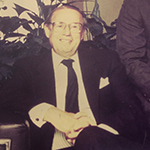
Gerald Blum
2019 Inductee, Trefoil Capital and Fidelcor
Gerald Blum learned about fraud the hard way: By experience.
He started his long career as an accountant, but quickly moved into the asset-based lending business. After a stint in the U.S. Air Force in World War II, he enrolled in New York University and graduated cum laude as an accountant in 1949. He joined a CPA firm, Klein & Ziegler in 1950, where he worked for three years while attending NYU at night studying for his MBA in finance.
After completing his MBA, he joined Jones & Co., an asset-based lender, as an auditor. He left after two years, a pattern set through most of his career because, he said, he kept getting offers from other lenders. He left Jones to join Lexington Financial, also as an auditor. Two years later he went with Jewelers Acceptance Corp. as an account executive and auditor. This was followed by six years, a record stay up to that point, as an account executive at Standard Financial Corp., which had purchased Jewelers Acceptance. In 1961, he went with Meinhard Commercial, at the time a unit of CIT, where he started an asset-based lending operation.
Two years later, in 1963, he moved again, this time to become executive vice president at Amsterdam Overseas, a U.S. asset-based lender owned by the Rothschild banking family of Great Britain. He stayed with Amsterdam Overseas until 1970 when it was sold to Aetna Financial. At the time, there was no pension program at Amsterdam Overseas but in connection with the sale, pension provisions were installed for Amsterdam’s principal officers.
“I still get a $572 check every month from that 1970 pension,” Blum said.
His career really took off in 1970 when he was engaged to start an asset-based lending unit for Fidelity Bank. This venture proved very profitable for the bank. Blum was named president of Fidelcor Business Corp., the bank’s ABL unit, largely because of his ability to adjust the process to the client’s needs.
For example, Fidelcor found a way to finance Larry C. Flynt, publisher of Hustler magazine, who was paralyzed in 1978 by a gunshot wound from a white supremacist. Flynt was not exactly a dream client. Most lenders wouldn’t touch him both because the product was highly offensive and it was tough to finance magazine sales because buyers had the right to return for full credit any unsold magazines.
Nevertheless, Blum saw the prospect of a profitable lending business, and by studying the pattern of returns over a about six years, was able to come up with a formula for advances. “Essentially what we did,” Blum said, “was advance 80 percent on 30 percent of the sales and it worked. However, when the bank got wind of the fact that we were financing a pornographic magazine, the bank’s board held a meeting to review the relationship.”
Members of the board, according to Blum, were old-line Philadelphians whose noses were mostly planted high in the air. They figured it just wasn’t fitting for the bank to be involved with such a trashy magazine. “But when they saw the figures and the amount of money we were making, they decided to overlook the product and agreed to continue the relationship.” Currently, many banks, accountants and lawyers are vying for Larry Flynt’s business.
Blum presided over Fidelcor for 17 years until he retired in 1989.
Professional Development Courses
- Live online classes for ABL and Factoring professionals
- On Demand classes in Appraisals, Factoring, Legal, Workout & Bankruptcy
Learn More

.jpg?sfvrsn=f1093d2a_0)
